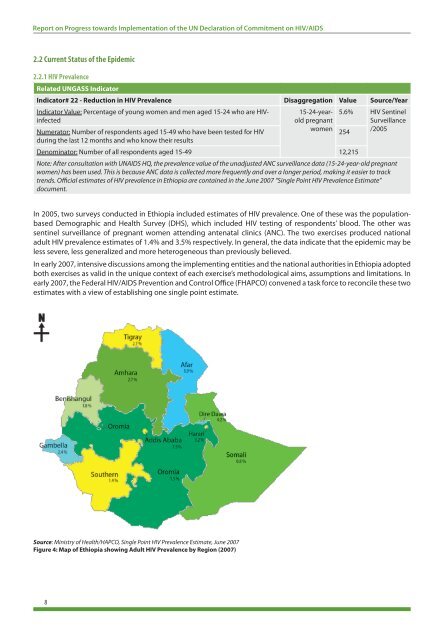Ethiopia - Country Progress Report - unaids
Ethiopia - Country Progress Report - unaids
Ethiopia - Country Progress Report - unaids
You also want an ePaper? Increase the reach of your titles
YUMPU automatically turns print PDFs into web optimized ePapers that Google loves.
<strong>Report</strong> on <strong>Progress</strong> towards Implementation of the UN Declaration of Commitment on HIV/AIDS<br />
2.2 Current Status of the Epidemic<br />
2.2.1 HIV Prevalence<br />
Related UNGASS Indicator<br />
Indicator# 22 - Reduction in HIV Prevalence Disaggregation Value Source/Year<br />
Numerator: Number of respondents aged 15-49 who have been tested for HIV<br />
during the last 12 months and who know their results<br />
Indicator Value: Percentage of young women and men aged 15-24 who are HIVinfected<br />
15-24-yearold<br />
pregnant<br />
women<br />
Denominator: Number of all respondents aged 15-49 12,215<br />
5.6% HIV Sentinel<br />
Surveillance<br />
254<br />
/2005<br />
Note: After consultation with UNAIDS HQ, the prevalence value of the unadjusted ANC surveillance data (15-24-year-old pregnant<br />
women) has been used. This is because ANC data is collected more frequently and over a longer period, making it easier to track<br />
trends. Official estimates of HIV prevalence in <strong>Ethiopia</strong> are contained in the June 2007 “Single Point HIV Prevalence Estimate”<br />
document.<br />
In 2005, two surveys conducted in <strong>Ethiopia</strong> included estimates of HIV prevalence. One of these was the populationbased<br />
Demographic and Health Survey (DHS), which included HIV testing of respondents’ blood. The other was<br />
sentinel surveillance of pregnant women attending antenatal clinics (ANC). The two exercises produced national<br />
adult HIV prevalence estimates of 1.4% and 3.5% respectively. In general, the data indicate that the epidemic may be<br />
less severe, less generalized and more heterogeneous than previously believed.<br />
In early 2007, intensive discussions among the implementing entities and the national authorities in <strong>Ethiopia</strong> adopted<br />
both exercises as valid in the unique context of each exercise’s methodological aims, assumptions and limitations. In<br />
early 2007, the Federal HIV/AIDS Prevention and Control Office (FHAPCO) convened a task force to reconcile these two<br />
estimates with a view of establishing one single point estimate.<br />
Source: Ministry of Health/HAPCO, Single Point HIV Prevalence Estimate, June 2007<br />
Figure 4: Map of <strong>Ethiopia</strong> showing Adult HIV Prevalence by Region (2007)<br />
8

















